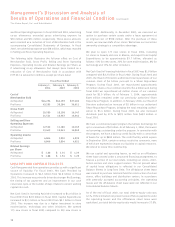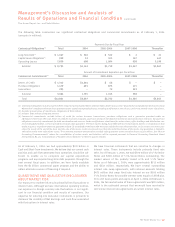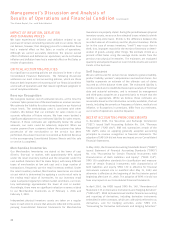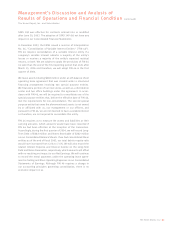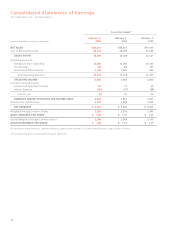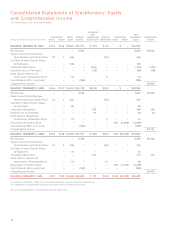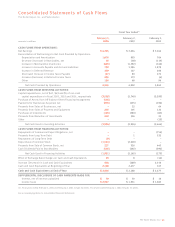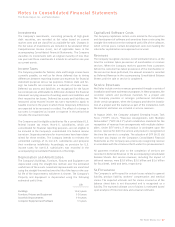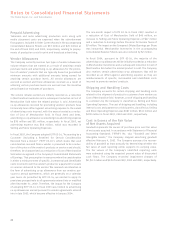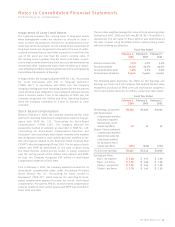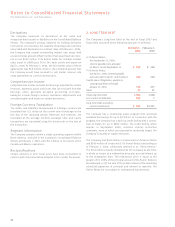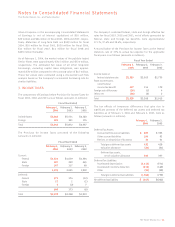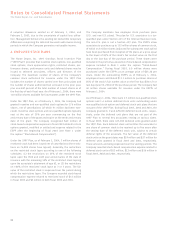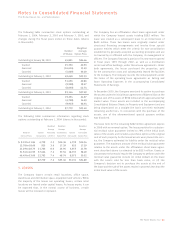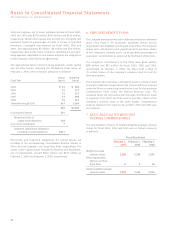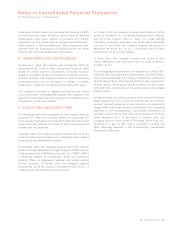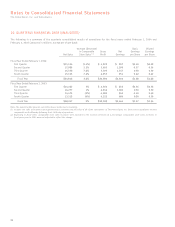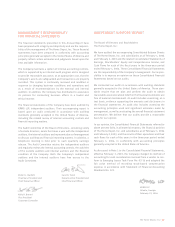Home Depot 2003 Annual Report Download - page 30
Download and view the complete annual report
Please find page 30 of the 2003 Home Depot annual report below. You can navigate through the pages in the report by either clicking on the pages listed below, or by using the keyword search tool below to find specific information within the annual report.Prepaid Advertising
Television and radio advertising production costs along with
media placement costs are expensed when the advertisement
first appears. Included in Other Current Assets in the accompanying
Consolidated Balance Sheets are $33 million and $20 million at
the end of fiscal 2003 and 2002, respectively, relating to prepay-
ments of production costs for print and broadcast advertising.
Vendor Allowances
The Company currently receives two types of vendor allowances:
volume rebates that are earned as a result of attaining certain
purchase levels and advertising co-op allowances for the promo-
tion of vendors’ products that are typically based on guaranteed
minimum amounts with additional amounts being earned for
attaining certain purchase levels. All vendor allowances are
accrued as earned and those allowances received as a result of
attaining certain purchase levels are accrued over the incentive
period based on estimates of purchases.
The volume rebates earned are initially recorded as a reduction
in Merchandise Inventories and a subsequent reduction in Cost of
Merchandise Sold when the related product is sold. Advertising
co-op allowances received for promoting vendors’ products have
historically been offset against advertising expense to the extent
of advertising costs incurred, with the excess treated as a reduc-
tion of Cost of Merchandise Sold. In fiscal 2002 and 2001,
advertising co-op allowances exceeded gross advertising expense
by $30 million and $31 million, respectively. In fiscal 2003, net
advertising expense was $58 million, which was recorded in
Selling and Store Operating Expenses.
In fiscal 2003, the Company adopted EITF 02-16, “Accounting by a
Customer (Including a Reseller) for Certain Consideration
Received from a Vendor” (“EITF 02-16”), which states that cash
consideration received from a vendor is presumed to be a reduc-
tion of the prices of the vendor’s products or services and should,
therefore, be characterized as a reduction of Cost of Merchandise
Sold when recognized in the Company’s Consolidated Statements
of Earnings. That presumption is overcome when the consideration
is either a reimbursement of specific, incremental and identifiable
costs incurred to sell the vendor’s product or a payment for assets
or services delivered to the vendor. We received consideration in
the form of advertising co-op allowances from our vendors pur-
suant to annual agreements, which are generally on a calendar
year basis. As permitted by EITF 02-16, we elected to apply its
provisions prospectively to all agreements entered into or modified
after December 31, 2002. Therefore, the impact for the Company
of adopting EITF 02-16 in fiscal 2003 was limited to advertising
co-op allowances earned pursuant to vendor agreements entered
into in late 2003, which became effective in January 2004.
The one-month impact of EITF 02-16 in fiscal 2003 resulted in
a reduction of Cost of Merchandise Sold of $40 million, an
increase to Selling and Store Operating Expenses of $47 million
and a reduction to Earnings before Provision for Income Taxes of
$7million. The impact on the Company’s Diluted Earnings per Share
was immaterial. Merchandise Inventories in the accompanying
Consolidated Balance Sheets was also reduced by $7million.
In fiscal 2004, pursuant to EITF 02-16, the majority of the
advertising co-op allowances will be initially recorded as a reduction
in Merchandise Inventories and a subsequent reduction in Cost of
Merchandise Sold when the related product is sold. The Company
also receives certain advertising co-op allowances that will be
recorded as an offset against advertising expense as they are
reimbursements of specific, incremental and identifiable costs
incurred to promote vendors’ products.
Shipping and Handling Costs
The Company accounts for certain shipping and handling costs
related to the shipment of product to customers from vendors as
Cost of Merchandise Sold. However, cost of shipping and handling
to customers by the Company is classified as Selling and Store
Operating Expenses. The cost of shipping and handling, including
internal costs and payments to third parties, classified as Selling
and Store Operating Expenses was $387 million, $341 million and
$278 million in fiscal 2003,2002 and 2001, respectively.
Cost in Excess of the Fair Value
of Net Assets Acquired
Goodwill represents the excess of purchase price over fair value
of net assets acquired. In accordance with Statement of Financial
Accounting Standards (“SFAS”) No. 142, “Goodwill and Other
Intangible Assets,” the Company stopped amortizing goodwill
effective February 4, 2002. The Company assesses the recover-
ability of goodwill at least annually by determining whether the
fair value of each reporting entity supports its carrying value.
The fair values of the Company’s identified reporting units
were estimated using the expected present value of discounted
cash flows. The Company recorded impairment charges of
$0, $1.3 million and $0for fiscal 2003, 2002 and 2001, respectively.
Notes to Consolidated Financial Statements
The Home Depot, Inc. and Subsidiaries
28


